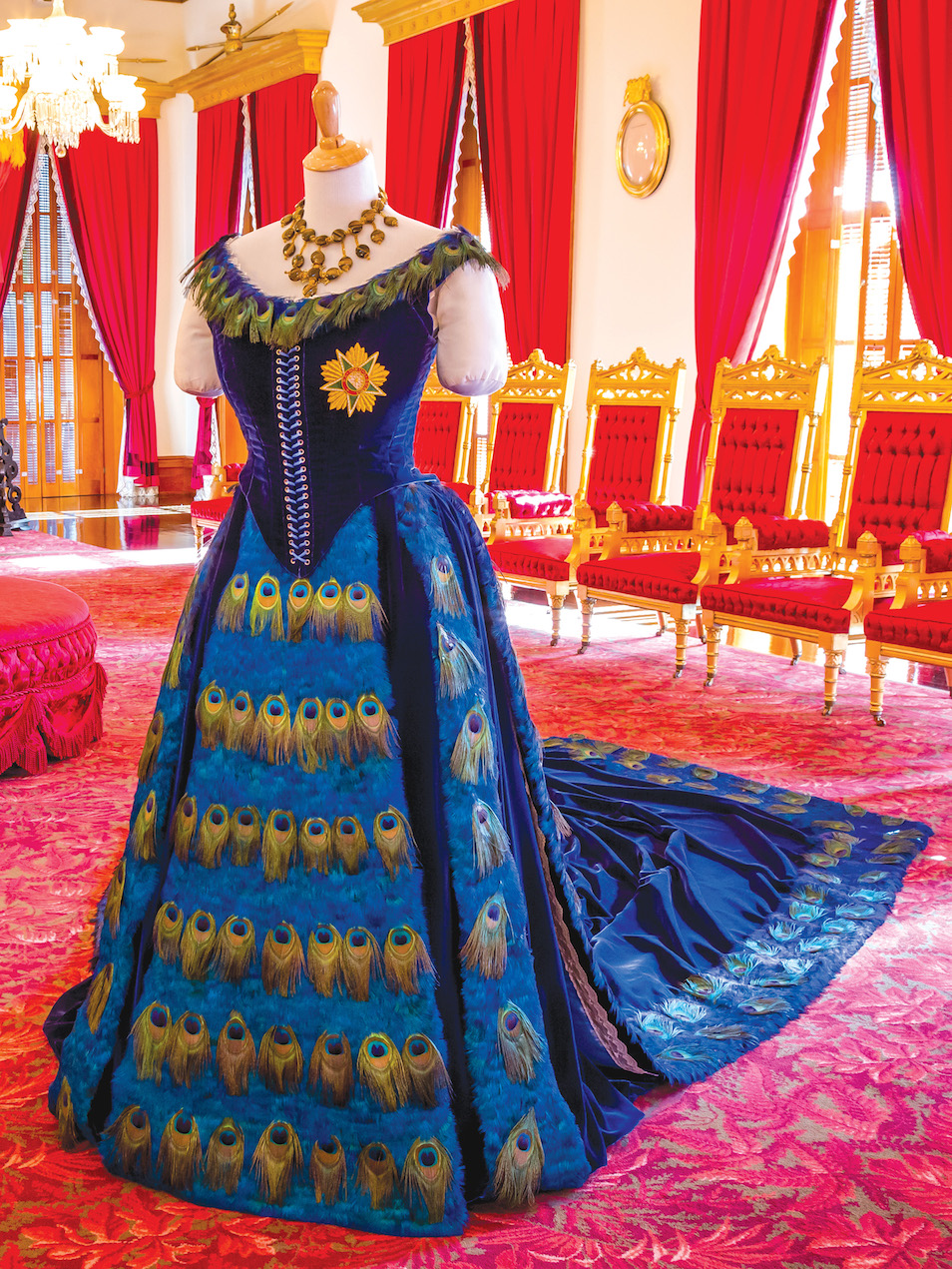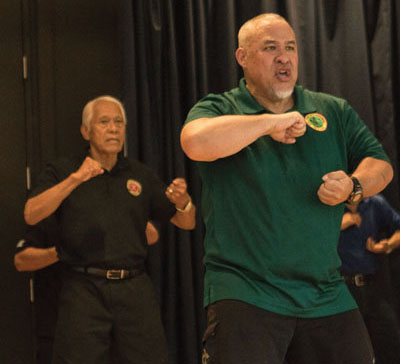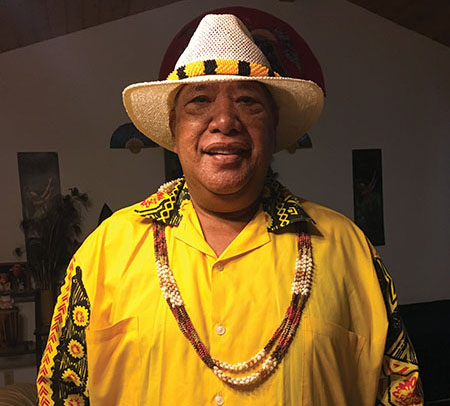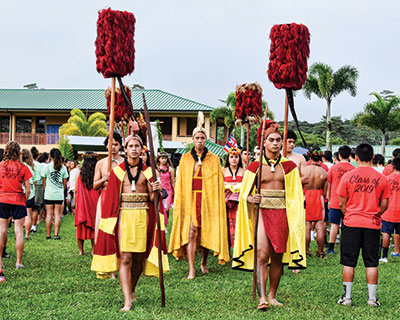
Makahiki: The Hawaiian Winter Holiday
By Leilehua Yuen
Long before Christmas was celebrated in Hawai‘i, we had our own winter holiday—the Makahiki. Makahiki can be a confusing word. It means “year,” “new year,” and also refers to the months-long season that heralds the new year in the Hawaiian calendar.
 Since the Hawaiian cultural renaissance began in the 1970s, more and more people are renewing celebration of the Makahiki. Depending on the group, the modern celebrations may be held any time from late October to late December. Some people celebrate it on the weekend of the American Thanksgiving holiday.
Since the Hawaiian cultural renaissance began in the 1970s, more and more people are renewing celebration of the Makahiki. Depending on the group, the modern celebrations may be held any time from late October to late December. Some people celebrate it on the weekend of the American Thanksgiving holiday.
It is celebrated with games and food, and some groups even raise the great Makahiki banner over the festivities, as in ancient times. In a modern take on the collection of food and goods, some schools and churches include a food drive for items which are then donated to charity.
In ancient times, as the old year drew to a close, the priests associated with certain temples on the western side of each inhabited Hawaiian island would watch for the appearance of specific stars or constellations.
On the island of Hawai‘i, they watched for Makali‘i—the Pleiades—a star cluster that appears in the evening sky in our October. When the priests could finally distinguish Makali‘i in the eastern sky shortly after sunset, they announced the next new moon would begin the Makahiki season. This was a time when warfare and most work were prohibited, and the people celebrated with games and sports.
Peter Michaud, Public Information and Outreach Manager at the Gemini Observatory here on Hawai‘i Island and former Planetarium Manager for the Bishop Museum in Honolulu, O‘ahu, says “I would guess there were probably heiau (places of worship) which had stones or some kind of protruding object which would show where Makali‘i would rise. The observer would watch for them at twilight. The time they could be seen would be variable, depending on atmospheric conditions, such as clouds and haze. It wouldn’t have been really exact, because that’s just the nature of these types of observations. . . Today we use a computer to figure out exactly when the Pleiades would rise at sunset.”
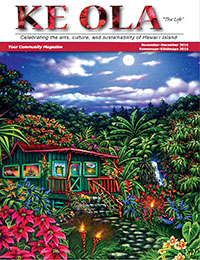
The Earth wobbles slightly as it spins through space. This wobbling takes many thousands of years to complete one full cycle. Yet, when the Polynesian explorers were arriving in Hawai‘i 1,500–2,000 years ago, the Pleiades rose about three days earlier than they do now. In practical use, however, this makes little difference to a four month festival and a rainy season which can vary by several weeks.
The exact method of calculation varies between districts and even families. This year, 2016, if one uses the dark sky rising of the Pleiades, Makahiki begins with the Hilo moon (beginning of the waxing crescent) on October 31. If one uses the earliest sighting of the Pleiades, Makahiki begins with the Hilo moon on December 1. The Hawaiian calendar marks the new day at nightfall, rather than midnight.
Details of the Makahiki varied from island to island and district to district. In general, Lono, as the god of fertility, held sway over the islands in this season. His image made a clockwise circuit along the coast of the island, with the celebrations beginning just before his arrival, and ending at his departure. The entire time Lono was traveling, warfare across the entire island was forbidden. Most work was also forbidden, and on specific days the kapu, the religious laws, were relaxed to allow people to farm or fish so that they would not starve.
Before the arrival of Lono-Makua (Father Lono) to preside over the Makahiki in a given district, taxes were collected in the form of offerings to Lono-Makua. The offerings included vegetables, taro, hard taro paste, sweet potatoes, chickens, dogs, dried fish, clothing, rope, feathers, feather lei, and anything else of value or needed for daily life. These things would support the functioning of the royal court to some degree in the next year.
Also, a ceremony lasting four or five days was held. This was called the Hi‘u-Wai (water splashing). Since the chilly months had arrived, fires were kindled on the beach. The people then bathed ceremonially in the sea, warmed and dried themselves at the fires, and then put on new clothing in honor of the new year.
The image representing Lono-Makua was made fresh each year. It was a long pole with an image of Lono at the top and a crosspiece just below the image. From the crosspiece were hung banners of white kapa, feather lei, and stuffed pelts of the kaupu bird (Laysan albatross). This image was known as the “Long God” of the Makahiki because it took the long way around the island, traveling throughout the season.
On coming into the district, Lono-Makua would be set up, as well as the Akua Pa‘ani, the god of sports. The eyes of the high priest would be blindfolded. The people then spent the next several days in sports and festivals. Demonstrations of boxing, spear throwing, sled riding, and other games and sports entertained the people of the district.
The carriers of the Long God were fed by the household of the district chief. His wife would clothe the image in a new malo (loincloth) and the chief would present it with a whale tooth lei.
The rain-bearing clouds arriving from the south-east were pointed out by the priests as signs of Lono’s coming, and the priests prayed to Lono-Makua for fertility for the land and for abundant harvests.
Throughout the ceremonies, the commoners and chiefs each had their own religious, as well as secular duties. The commoners prayed that the lands of their chiefs would increase in size and prosperity, and for the health of themselves and their chiefs. And, they prayed for success in their various endeavors.
The chiefs prayed for health, prosperity, and many descendants. It was felt that as the chiefs prospered, so would the lands and the people.
Meanwhile, an image called the “Short God” was borne in the opposite direction through the uplands. The upland people followed it as it traveled, gathering bundles of fern shoots to eat. The Short Gods were attached to a specific district, so upon reaching the opposite edge of the district, the Short God, unlike the Long God, returned to its place of origin.
When the Short God returned, a bonfire was lit. If the night had clear weather, it was considered an omen of prosperity. The following day the blindfold was removed from the high priest’s eyes and a fishing canoe was sent out. While those men fished, others gathered fern shoots from the forest. When the canoe returned, the male chiefs and other men ate a meal of the fish, probably with the fern shoots. This was repeated for several days. On the last day, the chiefesses and other women also ate the meal.
At the end of the district celebration, the priests would say a prayer to set the land free. The Long God was turned face down and carried away to the next district where the process began all over again.
The full circuit probably took the four months of the Makahiki season, yet no one district would have been under kapu and unable to work for the whole four months. The kapu on labor, and the games and feasting would have been in effect only during the time the gods were in the district.
On the day Lono-Makua returned at last to his district of origin, the high chief went to the sea to bathe. After being purified, the chief and his warriors took their canoes out to sea. This possibly was a reenactment of a portion of the legend of Lono.
The high chief and his warriors then returned to shore where they were met by a group of warriors set to resemble an opposing army. As the chief jumped ashore from his canoe, a retainer expert in the art of spear warding accompanied him. An opposing warrior threw a spear at the chief, and it was struck aside by the retainer. The opposing warrior then touched the chief with a second spear.
That afternoon, the two armies held mock battles and the high chief made offerings to Lono-Makua and the Short God. The next day a feast was prepared. It spent the night steaming in the imu (underground oven), and at dawn the feast was ready. All of the community took part in this sacred feast. Anything left over was carefully disposed of, much like modern communion wine. The same day, the Makahiki images were dismantled and placed in the temple.
Other ceremonies which closed the Makahiki festival included filling a net with large meshes with various foods. The net was shaken and watched to see how much fell through the meshes. If everything fell through, the following year would be prosperous.
A woven basket was also filled with food and lashed between the booms of an outrigger canoe. It was paddled out to sea and cut loose to drift as an offering.
Orders were given to cut timber for new structures within the heiau.
An unpainted canoe was put to sea and paddled back and forth signaling the lifting of the kapu on fishing, farming, and other work necessary to daily life.
While the common people now could return to their normal lives, the chiefs and priests continued wrapping up the religious observations. Then, over the next few days, the high chief was purified in a series of ceremonies and the remaining kapu lifted from various activities. At last the ceremonial duties were over. The high chief, the high priest, and the man who beat the ceremonial drum took a final sacramental meal of pork.
The new year could now begin
Kamehameha Schools Hawai‘i Campus in Kea‘au is one of the educational institutions perpetuating Hawaiian culture through their ‘Aha Makahiki, an on-campus peer-to-peer event in which seniors host workshops for the underclassmen. Mahalo to the staff and students for allowing us to feature their photos. ❖
Contact writer Leilehua Yuen: kumuleimanu@gmail.com
Bibliography
Native Planters in Old Hawaii: Their Life, Lore, and Environment; Handy, E. S. Craighill and Handy Elizabeth Green; Bishop Museum Press; 1972
Nā Pule Kahiko: Ancient Hawaiian Prayers; Gutmanis, June; Editions Limited; 2009
